MS PowerPoint - Lesson 5: Create a manual presentation slide
In the previous lesson, we showed you how to create a slide show with an available design with appropriate typefaces, color schemes and layouts. In this lesson we will learn the slide show format manually based on the color and layout that the program supports.
Select Layout for the slide of the slideshow
Slide layout in PowerPoint is the placement of components in a slide interface. Each slide contains different components with different content and typefaces. A basic slide is separated into title (title) and basic content.
Reveal the Slide Layout (if closed)
- From the Format menu, click on Slide Layout
Apply text layout to a slide
- From the Slide Layout, Text Layouts section, click on the special layout you want
- Text Layout usually contains only text. These layouts include: Text Slide (Text only), Title Only (Title only), Title and Text (Title and content), Title and 2-Column Text (Title and 2 internal columns) content), Title and Vertical Text (Vertical title and content), and Vertical Title and Text (Vertical title and text)
Apply content layout to a slide
- From the Slide Layout section, Content Layouts section, click on the layout style you want
- Content layouts include: Charts, Clip Art, Pictures, Tables, Diagrams or Organization Charts, or Media Clips
Apply content and text layout to a slide
- From the Slide Layout section, in Text and Content Layouts click on the layout you want
- Text and Content Layouts include text, in addition to blocking maps, tables . on the same slide.
Apply other layouts to a slide
- From the Slide Layout section, in Other Layouts click on the layout you want
- Other Layouts are layouts other than text, content, and textual content.
Background format for the slideshow
Backgrounds can be applied to slides, notes, and announcements in PowerPoint. Background options (Backgroud) can change colors, Gradient, Texture, Pattern, or Picture.
Select the background color for the slideshow
- From the Format menu, click Background
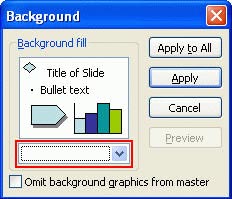
- Click the drop-down arrow and select the color you like, then click Apply .
- Click More Colors to select more colors
Select background effect for the slideshow
- From the Format menu, click Background
- Click the down arrow and select Fill Effects . The Fill Effects dialog box appears
- Select the Gradient , Texture , Pattern , or Picture tags to apply the effect. Choose the color you like.
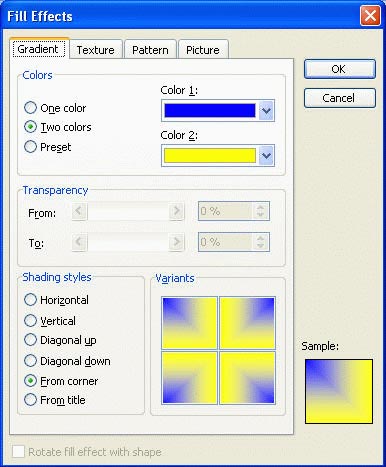
- After you've selected the appropriate color, click OK
- Back to the Background window, there are 4 buttons:
- Apply to All : Apply formatting to all browser versions
- Apply : Apply the background format to the current browser version
- Cancel : Skip the background format
- Preview : Preview the selected background color
- Click on the button you need
Presentation header and footer
Headers (Footers) and Footers include text, slides, or page numbers, and the date you want to display above or below a slide page. You can use the header and footer on each slide individually or apply to the entire presentation.
Insert Headers and Footers
- From the View menu, click Header and Footer . The Header and Footer dialog box appears
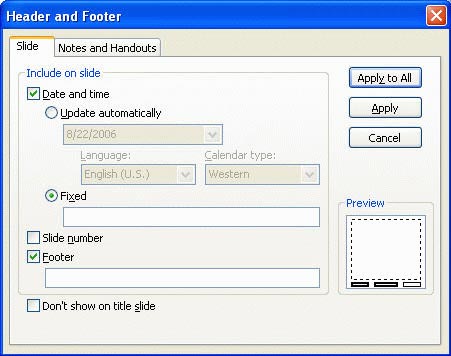
- To insert a date and time, check the Date and time box
- To number the page for the slide show, check the Slide number box
- If you insert the footer, make sure the Footer section is selected and type the content.
- Click Apply to apply to the current slide. Click Apply to All to apply to all slides.
Automatic numbering (Bullets and Numbering)
Bullets and Numbering is a tool for automatic numbering. Bullets and numbering let you choose different styles, sizes and colors that can be applied.
Add or unsubscribe
- To highlight text, you may want to add or remove bullet headers
- Click the Bullets icon on the Formatting toolbar
Change the line character style
- From the Format menu, click Bullets and Numbering
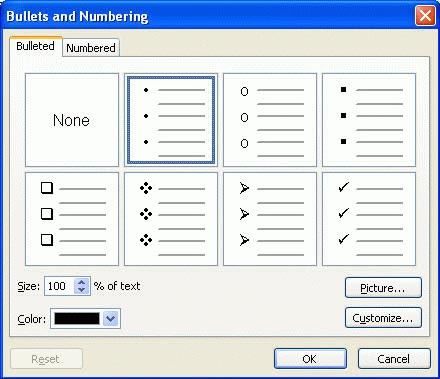
- Click on the type you want.
- Click OK
Create arbitrary bullets
- From the Format menu, click Bullets and Numbering
- From the Bullets and Numbering dialog box, click the Customize button to display the Symbol dialog box
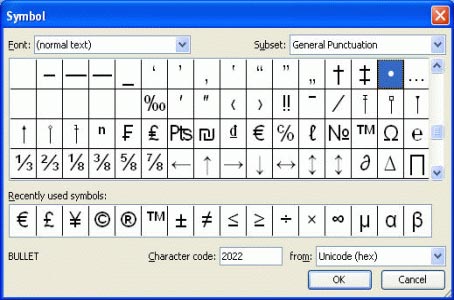
- Select an appropriate bullet type and click OK
Add or remove automatic numbers
- To highlight text you may want to add or remove automatic numbers
- Click the Numbering icon on the Formatting toolbar
Change the number type automatically
- From the Format menu, click Bullets and Numbering .
- Click Numbered . Select the type of automatic number you want.
- Click OK
Change the headline or automatic character color
- From the Format menu, click Bullets and Numbering
- Click the down arrow to drop down the Color menu box.
- Choose the color you like
- Click OK .
You should read it
- How to change slide direction vertically in PowerPoint
- How to Add a Header in Powerpoint
- Word 2013 Complete Guide (Part 6): Aligning page layout
- How to Hide a Slide in PowerPoint Presentation
- Design Layout - Website layout in CSS
- How to Become Familiar with OpenOffice.Org Impress
- How to Add an Object to a Presentation
- How to create text effects in PowerPoint
May be interested
- How to display a full screen PowerPoint presentation
 when powerpoint presentations with older versions will often appear two black bands along the sides of the screen. so what is a full screen powerpoint presentation?
when powerpoint presentations with older versions will often appear two black bands along the sides of the screen. so what is a full screen powerpoint presentation? - How to Use Microsoft Office PowerPoint
 do you want to make your presentation one to remember? powerpoint gives you the ability to create a powerful visual aid that can help make your presentation the best it can be. getting the most out of powerpoint takes some time, but with a...
do you want to make your presentation one to remember? powerpoint gives you the ability to create a powerful visual aid that can help make your presentation the best it can be. getting the most out of powerpoint takes some time, but with a... - Beautiful free PowerPoint slides for teachers
 whether you are teaching a class, teaching lectures, running an instructional program or training students, the following powerpoint slides are perfect choices. some templates provide you with tables, charts and diagrams, while others provide you with simple educational theme themes that match your presentation.
whether you are teaching a class, teaching lectures, running an instructional program or training students, the following powerpoint slides are perfect choices. some templates provide you with tables, charts and diagrams, while others provide you with simple educational theme themes that match your presentation. - Instructions to resize Slide pages in PowerPoint
 powerpoint is one of the useful microsoft office applications when you need a presentation, but do you know all of its features? have you ever needed to change the slide size in powerpoint? in this article, tipsmake.com will guide you how to do it!
powerpoint is one of the useful microsoft office applications when you need a presentation, but do you know all of its features? have you ever needed to change the slide size in powerpoint? in this article, tipsmake.com will guide you how to do it! - Summary of useful shortcuts in PowerPoint
 when you know and manipulate powerpoint with shortcuts, you will perform faster, slide shows easily compared to using manual manipulation.
when you know and manipulate powerpoint with shortcuts, you will perform faster, slide shows easily compared to using manual manipulation. - MS PowerPoint - Lesson 8: Design a PowerPoint presentation
 powerpoint's slide design pane has three easy ways to create a professional, harmonious and smart color presentation: design templates, color schemes, and animation schemes.
powerpoint's slide design pane has three easy ways to create a professional, harmonious and smart color presentation: design templates, color schemes, and animation schemes. - How to create PowerPoint slide frames
 when users add a frame to a powerpoint slide, the slide show will look better, attracting viewers.
when users add a frame to a powerpoint slide, the slide show will look better, attracting viewers. - MS PowerPoint - Lesson 10: Print PowerPoint 2003 presentations
 is it easy to print presentations, print powerpoint slides? see the instructions below to find answers. to print, microsoft powerpoint needs to have a printer driver system in the computer for the printer to be used. turn on the printer and put the paper in the tray of the printer. this is the guide to print powerpoint 2003 details for you.
is it easy to print presentations, print powerpoint slides? see the instructions below to find answers. to print, microsoft powerpoint needs to have a printer driver system in the computer for the printer to be used. turn on the printer and put the paper in the tray of the printer. this is the guide to print powerpoint 2003 details for you. - 106 tricks with Microsoft Office - PowerPoint
 in a microsoft powerpoint presentation, sometimes you want to hide a slide - reference information slides or further explain the meaning - and only access this slide when necessary. the hidden slides will not be displayed on the slide screen unless you instruct powerpoint to access the slide show.
in a microsoft powerpoint presentation, sometimes you want to hide a slide - reference information slides or further explain the meaning - and only access this slide when necessary. the hidden slides will not be displayed on the slide screen unless you instruct powerpoint to access the slide show. - Beautiful slide wallpapers for impressive presentations
 a beautiful powerpoint wallpaper will make your presentation slide stand out, more attractive, especially when finding a wallpaper that matches your presentation topic.
a beautiful powerpoint wallpaper will make your presentation slide stand out, more attractive, especially when finding a wallpaper that matches your presentation topic.










 Calculate the subtotal of the list on Excel
Calculate the subtotal of the list on Excel MS PowerPoint - Lesson 6: Drawing Toolbar
MS PowerPoint - Lesson 6: Drawing Toolbar MS PowerPoint - Lesson 7: PowerPoint design template
MS PowerPoint - Lesson 7: PowerPoint design template MS PowerPoint - Lesson 9: PowerPoint presentation
MS PowerPoint - Lesson 9: PowerPoint presentation